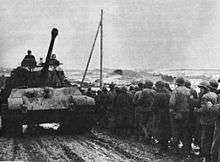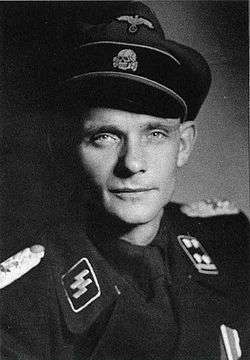Heinz von Westernhagen
| Heinz von Westernhagen | |
|---|---|
|
Heinz von Westernhagen | |
| Nickname(s) | Hein |
| Born |
29 August 1911 Riga, Latvia |
| Died |
19 March 1945 (aged 33) Veszprém, Hungary |
| Buried at | Veszprém, Hungary |
| Allegiance |
|
| Service/branch |
|
| Years of service | 1934–45 |
| Rank | SS-Obersturmbannführer |
| Unit | 1st SS Division Leibstandarte SS Adolf Hitler; I SS Panzer Corps |
| Commands held | 501st (101st) SS Heavy Panzer Battalion |
| Battles/wars | World War II |
| Relations | Dörte von Westernhagen (daughter) |
Heinz von Westernhagen (29 August 1911 – 19 March 1945) was a SS-Obersturmbannführer in the Waffen-SS during World War II. He was a member of the Leibstandarte SS Adolf Hitler (LSSAH) and commander of the 501st (101st) SS Heavy Panzer Battalion.
Early SS service
Westernhagen joined NSDAP in 1929 with membership number 174562, and later the SA. In April 1932, he joined the Allgemeine-SS. He joined the SS-Verfügungstruppe on 1 October 1934 and assigned to a company of the Germania Regiment. In 1936, he took platoon commander training course at Dachau Training Area, where he became acquainted with Jochen Peiper.[1] Afterwards Westernhagen was transferred to the Security Service (Sicherheitsdienst or SD).
World War II
Assigned to SS Division Leibstandarte SS Adolf Hitler, Westernhagen took part in the fighting in the Netherlands, Belgium and France in 1940. Afterwards, Westernhagen was transferred back to the Security Service (SD), returning to LSSAH in March 1941. During the Battle of Greece, he served in the staff of the Kampfgruppe Witt, commanded by SS-Sturmbannführer Fritz Witt. On 1 June 1942 Westernhagen became the commander of Leibstandarte Sturmgeschütz (Assault Gun) Battalion. Westernhagen remained on this position until 5 August 1943 when he was appointed to command the 101st SS Heavy Panzer Battalion.
Battle of Kursk
Westernhagen's unit was to operate in the southern sector of the planned operation.[2] The Assault Gun Battalion LSSAH commanded by Westernhagen was part of reinforced 2nd Panzergrenadier Regiment LSSAH; he sustained a head wound in the first day of the operation, on July 5. Westernhagen was evacuated that day, and later transferred to Berlin for additional surgery.[2] The head injury sustained during the Operation Zitadelle has plagued Westernhagen the rest of his life.
Westernhagen was appointed commander of the 101st SS Heavy Panzer Battalion on 19 July 1943. Further treatment of his head wound and subsequent participation in a training course for battalion commanders at the Armored Forces School in Paris delayed his arrival until 13 February 1944.[3] The 101st SS Heavy Panzer Battalion was heavily engaged during the Normandy campaign, and lost virtually all its equipment in the retreat across France in August 1944. The remains of the unit were ordered to rest and completely refit with the new Tiger IIs. On 22 September, 1944, it was redesignated as the 501st SS Heavy Panzer Battalion.[4]
Battle of Normandy
.jpg)
On 6 June 1944, the battalion was at Beauvais, 70 kilometres (43 mi) north of Paris. On that day in the early morning hours of 0600, it was placed on alert. Between 0200 and 0300 hours on 7 June, the Tiger battalion set off for the invasion front, on its own power, due to the extensive damage to the railway network northwest of Paris.[5] Initially, the Tigers drove through Gournay-en-Bray to Les Andelys. The bridge at Les Andelys to cross Seine was badly damaged, the battalion had to move through Paris. In an effective bit of propaganda, the Tigers rolled along the Champs-Elysées, passed the Arc de Triomphe to Versailles. March continued on to Falaise through Dreux, Verneuil and Argentan in the following days.[6]
The entire road march was an arduous and strenuous journey, in the area of Allied air superiority, started from day one, the march was often strafed by Allied fight-bombers and casualties mounted. Tigers could only drive out during the night with single tank movement, that is one tank at a time with lengthy intervals between vehicles up to several hundred meters. The road march was nearly 450 kilometres (280 mi) in distance, but took the battalion six days to reach. By the time the battalion has reached its designated assemble area during the night of 12 June 1944, it had suffered total casualties of twenty-seven, including nine killed. The long road march had also caused many mechanical problems and failures to the Tigers, of its theoretical strength of fourteen tanks, the 1st company ended with eight tanks; and the 2nd company, six. The 1st company assembled at Noyers (8 kilometres (5.0 mi) northeast of Villers-Bocage); the 2nd company assembled in a defile south of Montbrocq (2 kilometres (1.2 mi) norhteast of Villers-Bocage); the 3rd company was still held up farther to rear; von Westernhagen's battalion command post was established at Baron-sur-Odon. The battalion was immediately ordered to cover the left flank of the I. SS Panzer Corps, the crews had no rest.[3][7]
Battle of Villers-Bocage

In the days following the Allied D-Day landings of 6 June, both British and Germans regarded control of Caen as vital to the Normandy battle. When a 12 kilometres (7.5 mi) gap has opened up between 352nd Infantry Division and Panzer Lehr Division, the British 7th Armoured Division (Desert Rats) was given the mission to exploit through this gap and encircle Caen from the south-west to form what Montgommery has termed the 'right hook'.[8]
At 08:30 on 13 June 1944, the 22nd Armoured Brigade entered Villers-Bocage. The advancement conducted without additional reconnaissance was a costly mistake for the British as they were oblivious to the presence of 2nd Company, 101st SS Heavy Panzer Battalion. The Company commander, SS-Obersturmführer Michael Wittmann, engaged the British with a lone Tiger tank first along N175 as he advanced towards Villers-Bocage, and later in the town itself, until his Tiger was immobilized from an antitank gun.[8][9] The British withdrawal indicated the end of the post D-Day "scramble for ground" and the start of the a grinding attritional battle for Caen.[10] Westernhagen then went on a convalescent leave to deal with the aftermath of his head wound.
Battle of the Bulge

On 21 November 1944, Westernhagen returned to the battalion, now designated as the 501st SS Heavy Panzer Battalion. The plan for the Ardennes Offensive was to deliver a powerful blow and to regain the initiative in the West Front.[11] The main attack would be led by the 6th Panzer Army advancing from Monschau to Losheim, crossing the Meuse on both side of Liège and then advance on Antwerp. The advance roads were assigned to the 1st SS Panzer Division Leibstandarte and the 12th SS Panzer Division Hitlerjugend. Leibstandarte was to use Roads D and E, Hitlerjugend Roads A, B and C.[11]
The 501st SS Heavy Panzer Battalion was at full strength except for the 4th (Light) Company. Each panzer company possessed 14 Tiger IIs, gave a total strength of 45. However the battalion was plagued with maintenance problems and mechanical breakdowns, it is probable that only around 30-35 Tigers actually participated in the initial advance of Kampfgruppe Peiper.[12] Due to the blitz action KG Peiper needed as the spearhead of the offensive, considering the sixty-eight tonne Tigers could reach a speed of only thirty-eight kilometers per hour, and rough terrain and road conditions, the Tiger Battalion were placed to the rear of the march column from the beginning, formed as the rearguard. However, after leaving the hilly section of the offensive zone the Tiger Battalion was to be moved forward and spearhead the breakthrough to the Meuse.[13]
On 16 December 1944, due to 12th Volksgrenadier's (VG) slow progress in breaking through the American lines thus opening a gap for Route D, the Tiger Battalion just started to roll out from its assembly area at Tondorf. Wessel's 1st Company was in the lead, which brought up from the rear.[14][15]Panzergruppe Peiper evacuated Stoumont and Cheneux in the early evening hours of 21 December 1944 and withdrew his entire battle group to La Gleize, the small village thus became the center point of the pocket. The breakout began at 0200 hours on 24 December 1944, of the approximately 3000 men of Panzergruppe Peiper, 850 of them who could still walk, including wounded, assembled to begin the breakout. Among them were Westernhagen and other members of the battalion. In the morning hour of 25 December 1944 he and his group has reached the Leibstandarte Division's command post in Wanner after a 33 hours march.
Death
On 19 March 1945, Westernhagen received an order to leave the battalion and join the officer reserve; SS-Sturmbannführer Heinz Kling assumed command. According to the official statement, Westernhagen was killed by an aircraft bomb, however Wolfgang Schneider in his book 'Tigers in Combat' volume 2, with almost daily activity account of 101st/501st SS Heavy Panzer Battalion, has clearly indicated that Westerhagen has committed suicide after been relieved as battalion commander: "In fact, he shoots himself with his own pistol."[16]
References
- Citations
- ↑ Parker, Warrior, p. 16
- 1 2 Schranck, Prokhorovka, p. 42-55
- 1 2 Schneider, Tigers in Combat, p. 205
- ↑ Schneider, Tigers in Combat, p. 213
- ↑ Schneider, Tigers in Normandy, p. 2
- ↑ Schneider, Tigers in Normandy, p. 5
- ↑ Schneider, Tigers in Normandy, p. 4, 11
- 1 2 Schneider, Tigers in Combat, p. 206
- ↑ Schneider, Tigers in Normandy, p. 19 - 22
- ↑ Hastings, Normandy, p. 166
- 1 2 Parker, Ardennes, p. 12
- ↑ Walden, Tiger, p. 30
- ↑ Walden, Tiger, p. 29
- ↑ Cooke, Peiper, p. 30-36 (16 Dec. 1944)
- ↑ Walden, Tigers, p. 30
- ↑ Schneider, Tigers in Combat, p. 218
- Bibliography
- Bergström, Christer (November 1, 2014). The Ardennes, 1944-1945: Hitler's Winter Offensive. Havertown, PA: Casemate Publishers. ISBN 9781612002774.
- Buckley, John (2006). British Armour in the Normandy Campaign. (1st ed.). Taylor & Francis Ltd. ISBN 978-0415407731.
- Cooke, David; Evans, Wayne (October 19, 2014). Kampfgruppe Peiper: The Race for the Meuse. Pen and Sword. ISBN 978-1473827042.
- Hastings, Max (1999). Overlord : D-Day and the battle for Normandy 1944 (New ed.). London: Pan Books. ISBN 0330390120.
- Lee Ready, J. (2014). Dietrich's Boys: The Leibstandarte (HITLER'S FIGHTING SS UNITS OF WORLD WAR II) (Volume 1) (1 ed.). CreateSpace Independent Publishing Platform. ISBN 978-1495402746.
- Margry, Karel, ed. (2001). "After the Battle Number 112: The Four Battles For Kharkov". After the Battle. After the Battle. Battle of Britain International Ltd. (112): 10–41.
- Parker, Danny S. (2001). Battle of the Bulge : Hitler's Ardennes offensive, 1944-1945 (1st Da Capo ed.). Cambridge, MA: Da Capo Press. ISBN 978-1580970235.
- Parker, Danny (2014). Hitler's Warrior: The Life and Wars of SS Colonel Jochen Peiper. Da Capo Press. ISBN 978-0306821547.
- Reynolds, Michael (2001). Men of steel : I SS Panzer Corps : the Ardennes and Eastern Front, 1944-45 (1st Da Capo Press ed.). [New York]: Da Capo Press. p. 234. ISBN 978-1885119667.
- Schneider, Wolfgang (2005). Tigers in Combat II (1st ed.). Mechanicsburg, Pa.: Stackpole. pp. 203–262. ISBN 978-0811732031.
- Schneider, Wolfgang (2011). Tigers in Normandy (1st ed.). Mechanicsburg, PA: Stackpole Books. ISBN 978-0811710299.
- Schranck, David (2013). Thunder at Prokhorovka : a combat history of operation Citadel, Kursk, July 1943. Solihull: Helion & Company. pp. 42, 45, 48, 50. ISBN 1909384542.
- Walden, Gregory (2015). Tigers in the Ardennes: The 501st Heavy SS Tank Battalion in the Battle of the Bulge (1 ed.). Schiffer Military History. ISBN 978-0764347900.
- Westemeier, Jens (2007). Joachim Peiper : a biography of Himmler's SS commander. Atglen, PA: Schiffer Military History. ISBN 9780764326592.
